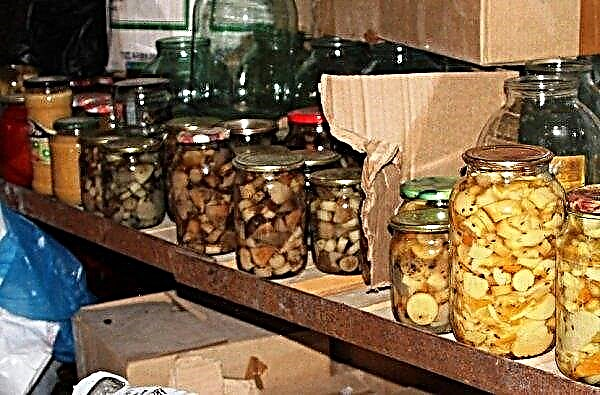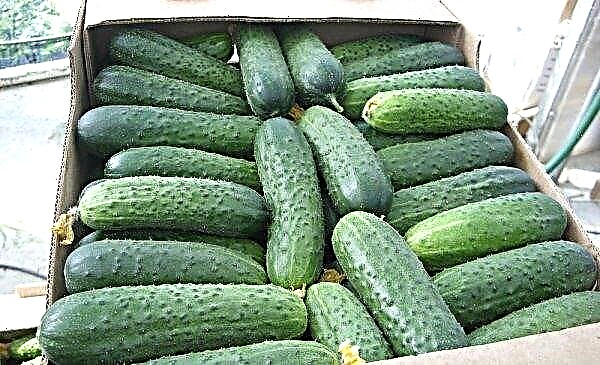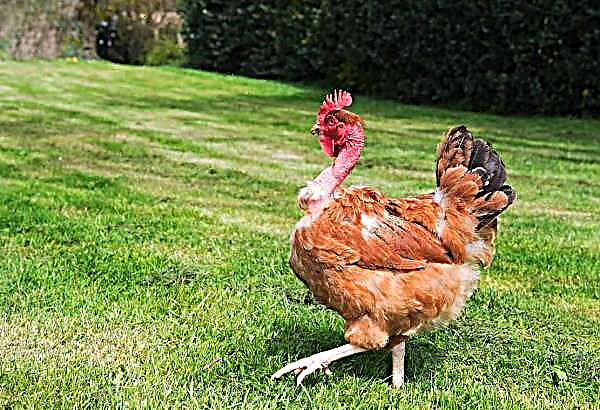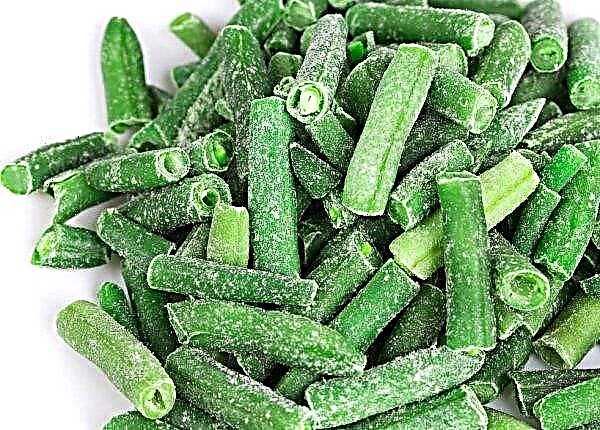Hydrangea is a "chameleon" in the plant kingdom. Its ability to change the color of buds is known to many florists. How the color changes, why this happens, and what should be done for this, read further in the article.
What varieties of hydrangeas can change color
Color change is not inherent in all varieties of this beautiful shrub. Tree and panicle species of the culture will not change the color of the petals, so you do not take. Only large-leaved garden hydrangeas can change it with proper care. When choosing a variety, it is worth paying attention not only to the color of future buds, but also to other parameters, such as: size of the bush, flowering period and frost resistance. The latter should correspond to the region of your residence. It is worth warning that the white inflorescences characteristic of a particular variety will not change color completely to color, only the veins will be painted. And hydrangeas with pink flowers change color well to blue or purple, which cannot be said about the opposite change.

Popular varieties of large-leaved hydrangea:
- Endless summer;
- Renata Steininger;
- Masya;
- Blue Wave;
- Tricolor;
- Spike
- Green Shadow;
- Cotton Candy et al.
Did you know? According to Japanese legend, the emperor once presented a bouquet of hydrangeas to his beloved family as an apology. Therefore, the flower is associated with sincerity and cordiality, which are manifested in grief and joy.
What color depends on
There is an opinion that the color of hydrangea varies depending on the acidity of the soil and varietal characteristics of the plant. This is partly true, but some important components must be present or absent in the structure and composition of the soil. Let's consider each in more detail.
Soil acidity
Soil pH has an important role in hydrangea cultivation. But the indicator affects not so much the color of the flower as the conversion of forms of chemical compounds inaccessible to plants into soluble and well-digestible ones. Therefore, the higher the acidity, the better the decay of chemical elements that play a key role in staining inflorescences.

Aluminum
Aluminum is the main factor for the formation of blue shades of flowers. In principle, it is present in the soil in sufficient quantity, but in a bound state, i.e., in a form inaccessible to the plant. An acidic environment is required to dissolve the element. In soil with a pH <5.5, its transformation occurs, it dissolves, and becomes available for shrubs. In neutral and alkaline soils, aluminum remains unchanged, which prevents its absorption and leads to a pink hydrangea.
The presence of phosphorus
Phosphorus (P) prevents the decay indicated in the previous paragraph, the element - Al. Therefore, in order for blue flowers to form, the presence of P in the soil must be minimized. To do this, potassium sulfate is introduced into the soil during digging, and nitrogen-containing complexes are introduced in summer and spring.
Video: How to change the color of hydrangea flowers
How to water hydrangea for color change
Based on the foregoing, the color of hydrangea can be changed by adding or removing some elements from the soil. So, thanks to watering with the addition of one or another component, you can tint the buds in various colors.
Watering with the addition of aluminum salts
Irrigation with water with salts of the said chemical element dissolved in it will give the colors blue, blue and even purple hues. This requires high soil acidity (pH 4.5–5.5).
It is necessary to water with settled water (before use it is collected in 3-4 days and allowed to stand in an open container) and the following additives:
- Alum Potassium Alum. To do this, initially make a solution (0.3%), after 2-3 irrigation - 0.5%. Irrigation is carried out every 14 days, under the root. Based on: for 1-2 bushes - 5 l, for older plants - 10 l.
- Aluminum sulphate. To obtain a working fluid, 15 g of the product are diluted in a liter of water, it should be used with the same frequency as in the previous case, the entire growing season.
Important! The introduction of any additives to change the color produced exclusively in moist soil, after which they abundantly watered around the trunk. Avoid getting funds on the plant tissue - this can lead to burns.
Fertilize with acidic additives with a minimum amount of phosphorus (5 parts), high potassium levels (20 hours) and a moderate nitrogen content (10 hours).. In this case, the use of superphosphate and bone meal is excluded.
A pink tint is obtained at pH> 6. But you need not to overdo it, the acidity should not be higher than 6.5 units, since negative consequences in the form of chlorosis are possible. It is optimal to maintain a pH of 6.2. Dolomite flour, lime or chalk is added once a season to acidic soil. As additives, complexes with nitrogen, phosphorus and potassium are used in a ratio of 25:10:10. Pink hydrangeas should not be planted next to azaleas, rhododendrons, heather, as these plants need acidic soil, which will negatively affect the color of the former and the development of the latter.

Watering with citric acid
To maintain the acidity of the soil, and, accordingly, to give the necessary shade, you can water the bushes with water with the addition of citric acid. For this, 2 tbsp. l powder is bred in a bucket of water. It is necessary to carry out the procedure from the beginning of the active period of plant vegetation. Watering interval - once in 7-10 days. "Lemon" can be replaced with oxalic acid in the same proportions.
How to change the color of hydrangea folk remedies
Folk florists use various improvised means to give hydrangea flowers various shades. Such methods not only change the coloring of the plant, but also contribute to the healthy development of the bush.
Did you know? In order for the cut flowers to stand longer, their stems are first dipped in cold water, then in boiling water, and only then placed in a vase.
Potassium permanganate
Irrigation with a solution of potassium permanganate (0.3%) contributes to an increased degree of assimilation of aluminum, which allows you to color the buds in blue and blue shades. A weaker concentration will lead to pink tones of the petals, and a concentration of 1% solution will make the buds purple.
- More potassium permanganate:
- prevent the development of pathogenic microflora;
- will enhance flowering and development of peduncles;
- maintain the boundaries of the hydrogen index;
- Strengthens and gives flexibility to wood and stems.
 You should wait for the dissolution of the crystals of the drug, otherwise a burn of the plant is possible. It is worth remembering that this method only works with regular use, after stopping watering the buds will get their original color
You should wait for the dissolution of the crystals of the drug, otherwise a burn of the plant is possible. It is worth remembering that this method only works with regular use, after stopping watering the buds will get their original color
Vinegar
From the beginning to the end of the growing season with an interval of 14 days, watering the bushes with acetic acid is carried out. For this, 100 ml of the drug is diluted in a bucket of settled water. About 1 such dose is needed per 1 m². The principle of action is similar to citric acid.
So, based on the foregoing, the color of the buds depends on the acidity and content of aluminum salts in the soil. A brief ratio of the hydrogen index and the color of the petals:
- pH <5.5 - will lead to a blue color;
- from 5.5 to 6.5 - to purple tones;
- pH> 6.5 - “color” hydrangea in pink and red colors.
Important! If it is impossible to maintain the necessary acidity of the soil for a long time, flower growers recommend growing hydrangea bushes in pots.
At the same time, it is worth remembering that you can not exceed the acidity of more than 8, as this will lead to plant disease, but alkaline soil is also undesirable. It is necessary to carefully monitor the acidity of the soil so as not to harm the plant. To do this, it is better to purchase a tester or litmus strips in special outlets.

How to keep a custom color
Do not expect global changes in the first season of applying various methods. It may sometimes take 2-3 years to achieve the desired results. But if you get the necessary color, then you should continue to maintain the necessary acidity of the soil, and feed them with appropriate fertilizers. Also for this purpose use mulch - sour peat, coniferous sawdust, etc.
Growing a gorgeous hydrangea beauty in your area is a long process, but the result will surprise you with bright colors and lush flowering. The main thing is to observe the acidity of the soil and the presence of aluminum salts in it, as well as choose a variety that needs to be repainted.












